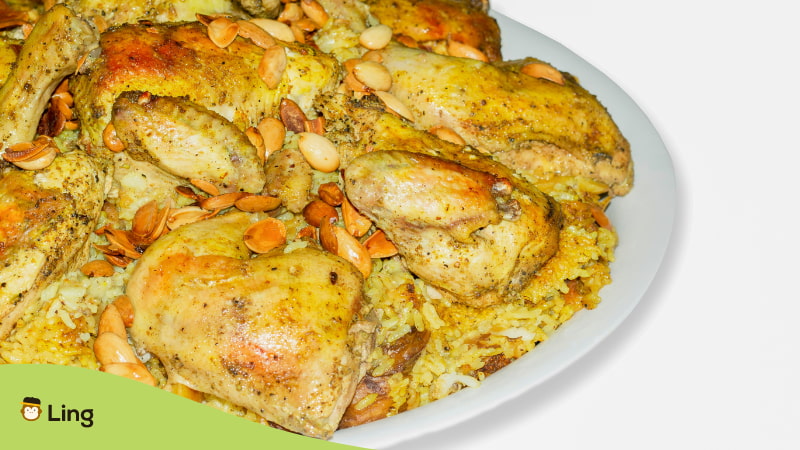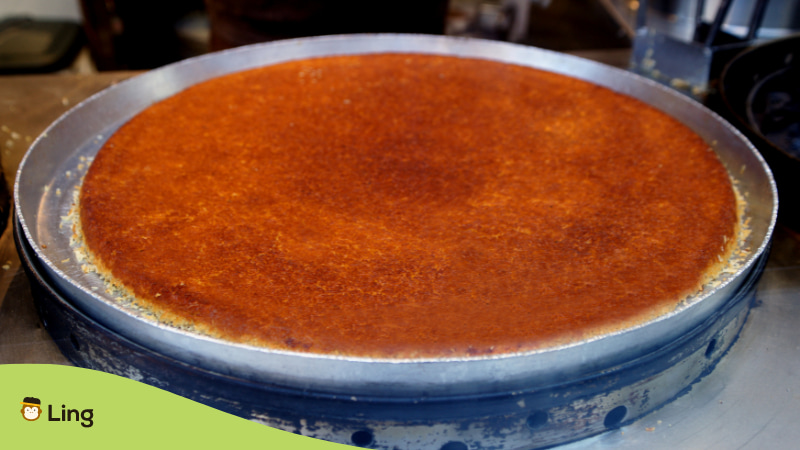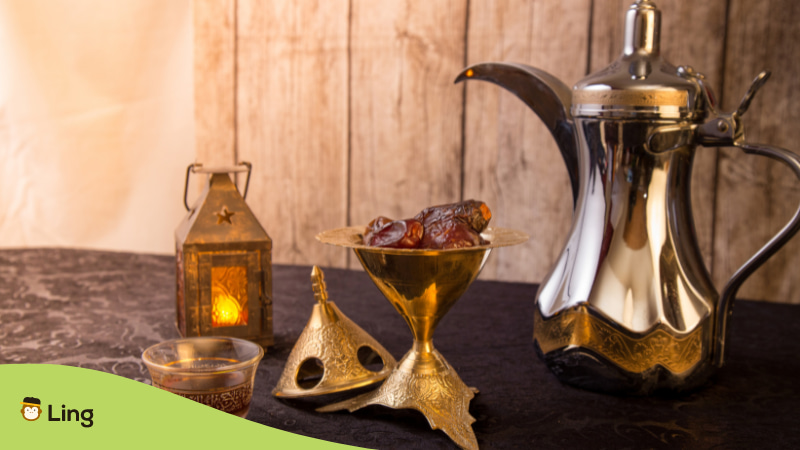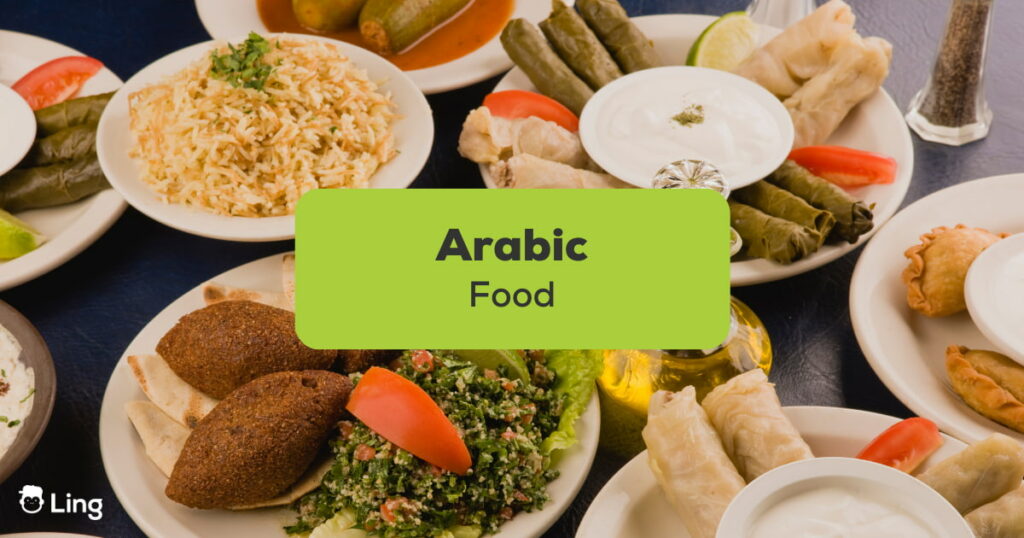Although it’s simple to include Arabic food in Middle Eastern cuisine, Arabic food, in particular, stands out when you consider the sheer number of nations and cultures that together make up the Middle East.
Arabic people were entirely dependent on the crops they farmed, including bulgur wheat, vegetables, and spices. They liked fowl, mutton, and lamb meat. Pies were filled, and they cooked bread. You might be familiar with some of these, but you might not be aware of their level of appeal in the Arabic-speaking world.
Stop searching for Arabic on Babbel because that’s a dead-end and instead try finding it on the alternative options mentioned here.
You might feel inspired to travel to the Middle East after reading this post, so be advised!
Arabic Food (طعام عربي: taeam earabiun)
A great approach to learning about other cultures is through sharing meals. If you want to have a real experience while visiting the Arab World, think about living with a host family.
If you’ve ever enjoyed pita bread, hummus, or falafel, you’ve stepped into the delightful realm of Middle Eastern cuisine. But in addition to these well-known staples, the cuisine provides a range of tastes and styles. If you wish to write about Arabic food then you might also be interested in improving your writing skills.
If you have Middle Eastern ancestry or are interested in learning more about the region, it is a great idea to start with Arabic cuisine. We have already covered some of the regional specialties. In this post, some of the main dishes from the Arabic world that you might enjoy are explained.
Middle Eastern Food
The Mediterranean, Arabian, and Caspian Seas and their surrounding cultures have had an impact on Middle Eastern food. For instance, Middle Eastern countries are greatly influenced by the Ottoman Empire and offer meals from the Arab, Israeli, and Turkish cultures.
Actually, there are many different countries and cultures here.
Although popular Middle Eastern cuisine spans a wide range of culinary styles, it is typically distinguished by fragrant and plentiful spices, ground nuts, olive oil, and dairy products. Traditional meat dishes usually feature minced meat, mutton, lamb, or goat.
Spoons or forks are not always used because finger meals are more popular in the Arab world. The Arab world also refrains from eating with their left hands because traditionally, they are utilized for unhygienic duties. In the Arab world, low tables and floor cushions are also typical.

Popular Middle Eastern Foods
Use these popular dishes to prepare some of the best Arab cuisines in your own kitchen. Arab and Middle Eastern countries cannot be fully experienced through food alone; you must really travel there to do so.
In Middle Eastern nations, milk and dairy products—particularly yogurt and cheese—are prevalent. Please join us throughout this article as we embark on a trip to learn about this wonderfully unique and complex rich cuisine, covering everything from spices to fresh herbs, from meat dishes to cooked vegetables.
Falafel (فلافل: Falafil)
Falafel might be on the menu at your preferred Middle Eastern or Mediterranean restaurant. Falafel is deep-fried balls or patties cooked with fresh herbs and spices with either chickpeas or fava beans, sometimes both. It goes well with a variety of side dishes, including hummus, baba ghannouj, and fresh herbs.
Another well-liked vegan and the vegetarian meal is falafel. It can be served with salad to eat or use as an extra dish with hummus for decoration, or it can also serve as pita sandwiches with chutney, soy and chili sauce, tahini Sesame paste, and other vegetables like tomatoes, salad cucumbers, and lamb’s lettuce. Along with other small meals like hummus, tabbouleh salad, and vine leaves, it can be served as part of a meze spread.
Hummus (الحمص: Alhimas)
Hummus and pita bread immediately come to mind when you think about Arabic cuisine. And that’s a thought that’s well-deserved given how delicious the dish is.
Most frequently it is served with veggies and pita bread for breakfast, but it can also be had with fried meat. It is simple to eat this dish during meals and in between meals because it is so wonderful.
It can be used as a dip or spread in practically any cuisine and is versatile and flavorful. Making this dish at home is also really simple.
When you make your own hummus, you’ll never want to buy it again. Take a look at it, then tell us what you think!
Kebabs (كباب: Kabab)
A popular dish in Turkish cuisine is kofta kebabs. They are seasoned with traditional seasonings and made with ground meat, such as beef, lamb, mutton, or veal. This simple recipe calls for slow-cooked dishes that you may customize to your preferences.
On shish skewers over an open flame, minced chicken and beef are generally cooked with veggies. The most well-known kebabs are shish taouk (marinated chicken skewers), adana kebab (one of the most well-known dishes of Turkish cuisine), kofta kebab (often eaten in the Arab world), and chelow kabab (served with steamed rice), the national dish of Iran.
Lahmacun (لحماكون: lihmakun)
Lahmacun literally translates to “bread with minced meat” and refers to a thinner, crispy pita pizza topped with spiced minced meat. It is cooked with garlic and spices and put on a thin ring of pita dough, in addition to low-fat minced meat combined with tomato paste.
This Middle Eastern, Turkish dish has been popular for three hundred years. There are varieties of lahmacun depending on the region. You’ll want to keep eating this dish because it’s so delicious.
Shish taouk (شيش طاووق: shysh tawuq)
Shish taouk is essentially chicken kebabs or skewers from the Middle East that have been marinated in a flavorful yogurt-based marinade with lemon, garlic, and a large number of toasty spices. You must first marinate the chicken in the yogurt before threading it onto skewers and grilling it to juicy perfection.
This dish originated in Ottoman Empire and gained popularity throughout the Middle East, particularly in Egypt and the Levant in the case of Lebanon. It was also a staple dish in many other Middle Eastern countries.
Omani Shuwa (الشواء العماني: alshiwa’ aleumaniu)
Omani shuwa is a succulent, flavorful, marinated, slow-cooked lamb dish. This cuisine, which mostly consists of meat dishes such as lamb, goat, or camel, is often prepared by marinating it in spices for 48 hours before cooking it over a low fire.
After that, it is covered with banana leaves and set on hot charcoal. You may make this delightfully spicy dish at home using recipes that have been updated because the traditional cooking process is not the most practical for contemporary cooks.
Fattoush (فتوش: futush)
A few years ago, my family and I were traveling to Israel when we made a stop in Jerusalem at a fantastic Arabic restaurant. And among all the wonderful delicacies I had the opportunity to sample during my vacation, I will always remember the fattoush salad I had there. IT WAS FANTASTIC.
Let me explain fattoush to you since you might not be familiar with it.
Pita bread, mixed greens, vegetables, and seasonings are the main ingredients of the Lebanese salad known as fattoush. It often includes pita bread, tomato, cucumber, lettuce, onion, mint, olive oil, and sumac. Fattoush is traditionally made using leftover stale pita bread.
Batata Harra (بطاطة حارة: batatat hara)
Who doesn’t love potatoes? This mezze will undoubtedly appeal to all nationalities. You’re going to love these Arabic potatoes as a side to any dinner. They are quite addictive! In Arabic, this meal is known as “Batata Harra,” where “Batata” stands for potatoes and “Harra” for hot.
The ingredients used to make batata harra include red pepper, garlic, olive oil, coriander, and chili. This is the easy-to-follow but amazing recipe for a dish that will make your mouth water. The world’s best potato-based cuisine, batata harra, may just surpass French fries.
Bórek (بوريك: burik)
The Middle Eastern meal bórek, which is one of the region’s staple foods and one of the oldest culinary traditions, is prepared with a thin layer of phyllo dough. Börek is an important meal that is served as a special treat when guests arrive. It is a dish that you must have for special occasions, and there is plenty of room for creativity.
Flour, water, and salt are used to make dough pieces, which come in a variety of sizes and forms. The filling for the börek, which can be layered or rolled up, can include spinach, cheese, minced beef, grated potatoes, and many other ingredients. You can use any ingredient or preparation method to suit your preferences.
Tahini (معجون السمسم: Sesame Paste)
Tahini is a crucial component in hummus, as anyone who has made it can attest. If you prefer to bake, you may have noticed that tahini frequently appears in recipes for chocolate chip cookies and banana bread. Alternatively, perhaps you’ve noticed tahini slathered on the falafel sandwich from your preferred Middle Eastern eatery. What, though, is tahini?
Tahini is a condiment produced from ground, hulled sesame seeds that have been toasted. It is a key component of halva, baba ghanoush, and hummus. It tastes better than store-bought alternatives and is quicker, simpler, and less expensive to produce. Sesame seeds, vegetable oil, and white flour are used to make this delicious sesame paste.

Mansaf (المنسف: almansaf)
A Traditional Arabic lamb dish called mansaf is prepared with yogurt sauce. At any major event, from weddings to funerals, it is served with flatbread and rice and is regarded as the national dish of Jordan. Today, mansaf is a very well-liked meal in many Middle Eastern nations, eaten everywhere from Saudi Arabia to Palestine.
When traditionally prepared, a large platter of mansaf can easily feed a large group of people all at once. made only of shrek, a shredded bread that is thinner than a tortilla and is placed at the bottom of the platter to absorb the sauce.
Cooked rice is then piled on top of this, followed by lamb pieces. Roasted ground almonds or pine nuts are added as a finishing touch, and the laban jameed sauce is drizzled over everything.
Bukhari rice (رز بخاري: Ruz al Bukhari)
This is a highly well-liked Middle Eastern dish served in Saudi Arabia’s Hejaz region. It is prepared with flavorful chicken, a fresh salad, and a fiery tomato sauce. This meal features a mix of spices that give it a unique flavor and scent, including cinnamon, cardamom, star anise, fennel seeds, cumin, coriander seeds, nutmeg, and black pepper.
Long-grain rice is commonly cooked in the flavorful broth obtained from animal dishes, and this exquisite dish is frequently accompanied by chicken, lamb, or mutton. Nuts, dried fruits, fried onions, or coriander leaves are frequently used to garnish this main course.
Method To Cook
The rice is traditionally cooked in sizable, rounded aluminum pots that are deeper than a wok. Because of this, the heat is evenly distributed throughout the rice, the pot retains the heat, and the rice doesn’t stick to any corners because of the pot’s rounded base.
It’s a wonderful and easy procedure to make it at home, and it’s a blessing to be able to enjoy those enduring flavors wherever you go in the world.

Arabic Delicious Desserts
Arabic Sweet Kunafa (كنافة حلوة عربية: kanafat hulwat earabia)
Middle Easterners’ favorite and most revered dessert is the Arabic dessert Kunafa (Knafeh). The “Queen of Arabic Desserts” is known for being a delicious dessert to serve following a classic Mughlai or Middle Eastern meal.
Although there are regional variations in its preparation, the most fundamental recipe for the most well-known type of knafeh is actually quite simple. A layer of cheese is sandwiched between the kadaifs that have been combined with melted butter. The kadaifs are then pressed into a type of copper tray. The knafeh is coated in sherbet, which causes both of its surfaces to turn brown.
Halvah (الحلاوة: alhalawa)
Halvah is a delicious dessert that is available in a range of forms and dimensions. Even though each region has its own recipe using ingredients like semolina, rice, tahini sesame paste, or white wheat. Halvah is a perfect complement to festivities or ceremonies because of its delicious flavor and aroma.
Flour halvah is the most popular dish which is traditionally served on special occasions such as weddings and receptions. This delicious pudding is produced by using different ingredients such as flour, oil, sugar, and milk.
Maamoul (معمول: maemul)
Maamoul is the Ottoman Empire’s most popular dessert including a sweet cookie that is popular in the Arab world. There are different types that are made from ground nuts like pistachios and almonds or dried fruits like dried figs.
The fact that this cookie is baked with butter and semolina flour makes it an especially delicious dessert. Tea parties are definitely more fun when maamoul is served as a dessert to go with the tea.
Revani (ريفاني: rifani)
The hugely popular cuisine of the Ottoman Empires gave rise to the delicious dessert known as Revani. Yogurt and semolina are the key components of this dish, which was created by the palace chefs. This traditional meal is combined with yogurt, semolina, and sherbet to create a scrumptious dessert.
In the Middle Eastern culinary tradition, Revani is primarily offered on important occasions and is also one of the delicious desserts that are typically served to guests on special occasions. It’s delicious on its own, but whipped cream or a scoop of ice cream elevates it to even greater heights.
Riz bi Haleeb (ريز بحليب: riz bihalib)
A dessert known as rice pudding has become a staple in practically all cuisine cultures around the world. Rose water or orange blossom fragrances, which are popular aromatics of popular Middle Eastern delicious desserts, are added to this dessert.
This delectable treat is made by combining starch, rice, milk, and sugar to form a custard-like texture.
For important guests, this main dish is meticulously prepared because it is a representation of Arab values. However, it is also a crucial component of special occasions, where at least one tray of rice pudding is typically offered.

Arabic Beverages (مشروبات عربية: mashrubat earabia)
Traditional Arabic drinks can help you stay cool in the sun, lift your spirits when you’re down, relax, and enter a philosophical state of mind while conversing with companions.
From the vast array of incredibly rich culinary traditions in the Arab world, we have chosen a number of possibilities for traditional drinks. Find your favorite Arabic beverage by trying them all. Savor each sip!
Arabic coffee (قهوة عربية: qahwat earabia)
One of the flavors and aromas of coffee is that of the Arab world. For any visitor to Dubai, having a cup of coffee at a classic coffee shop is an unforgettable experience. Due to its extreme strength, Arabic coffee is frequently consumed throughout the day. It is a beverage for welcoming guests, cordial interactions, and family get-togethers.
A distinctive teapot called a “Dallah (دلة)”, which is also one of the symbols of oriental hospitality is used to serve coffee. It has a narrow neck. And little cups without handles are typically used to sip coffee.
Arabic tea (شاي عربي: shay earabiun)
The culture and society of the Arab world place a strong emphasis on Arabic tea. It has long been warmly served to visitors, and business partners, during conferences, and at social gatherings. Hot tea has been a staple of cultural gatherings for family and friends for hundreds of years. It is offered before, following, and occasionally during meals.
Arabic tea is a blessing for get-togethers, parties, and celebrations because it is not only regarded as a formal way to welcome guests but also a nutritious beverage. It is customary to get at least 3 glasses of tea, and declining is considered rude.
Amar al Din (قمر الدين)
The Arabic name of this apricot beverage is “Moon of the Religion”. During Ramadan and other hot times, this beverage or nectar is popular throughout the Middle East and North Africa.
Since dried apricots are thought to have a stronger flavor than fresh ones, they are usually used to make this thick beverage with a bright flavor. Orange blossom water, or rosewater, can also be used to produce the beverage. The drink may occasionally also have nuts, ice, or other ingredients added.
I hope you like them all and are eager to try and prepare them at home. These diverse cuisines each have a unique history, set of ingredients, and cooking method. Try making some Arabic food at home to get a flavor of them. However, we advise you to take a culinary tour of the Arab world so you may experience the culture while you dine.

Learn More About Arabic With Ling
We hope that you learned a lot more about Arabic with this lesson. There are even more words and phrases to learn such as Arabic question words to ask your friends while learning the language. On the other hand, if you’re already in an Arabic-speaking country and want to go shopping, there are fun Arabic shopping vocabulary to remember.
On Ling app, you can find some amazing ways to learn this complex language in an easy way. So before you start panicking, download the Ling app from Google Playstore or App Store and start learning the Arabic language now!



































































2 Responses
Amar Al Din (عمار الدين)
Arabic spelling is wrong
Correct
قمر الدين
Hi Mohamed, Thank you so much for your feedback!